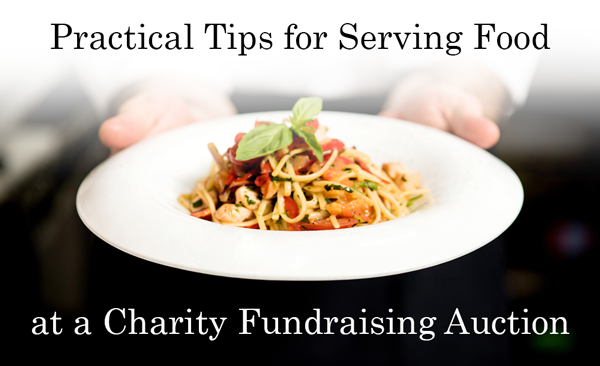English author Virginia Woolf once wrote, “One cannot think well, love well, sleep well, if one has not dined well.”
We believe the same is true for giving well.
Many fundraising events revolve around food – think evening galas with multi-course meals; golf tournaments with buffet lunches; rotary auctions with brunch and more. Why? For one thing, donors need nourishment to make it through a 4 hour event.
What’s more, meals also provide the chance to sit down and socialize, celebrate your cause in community and provide an all-inclusive “fun night out” for couples and friends.
A meal’s execution can heavily impact donors’ experience and overall success of the event, for better or worse.
Check out practical tips for seamless food service in any event, including:
You’ll also learn a neat way to generate more income for your cause from serving dinner. If you plan to feed guests, you’ll want to read and bookmark today’s post!
Scenario 1: Gala with Three Course Meal
It’s finally time for the annual charity ball or gala. Your guests have arrived dressed to the nines, eager for a fun evening. The energy is palpable.
The more you can cater to guests’ finer tastes, the more your auction event will come across as a luxury shopping spree – and the higher bids will go!
Here are a few easy ways to help make your gala dinner a success.
-
Consider conducting the live auction during dinner.
Where you schedule the live auction can depend on your audience and other elements in the program, but let’s first look at when not to have your live auction: late in the evening.
Suppose you’ve opened the doors to your event at 5:30 for cocktails. An hour goes by. Now people are sitting for dinner at 7. There’s wine on the table, they’re having more drinks, then enjoying a big meal and decadent dessert. All the while, folks are looking at the silent auction tables and refreshing their drinks. Suddenly it’s 9:30pm and time to start the live auction. How will you go about getting everyone seated and focused?
There’s a better way.
Instead, try holding your live auction during dinner. Here’s what benefit auctioneer Danny Hooper appreciates about this technique:
“In my experience, dinner is the best time to hold the live auction. Time and again I’ve proven this to many of my clients.
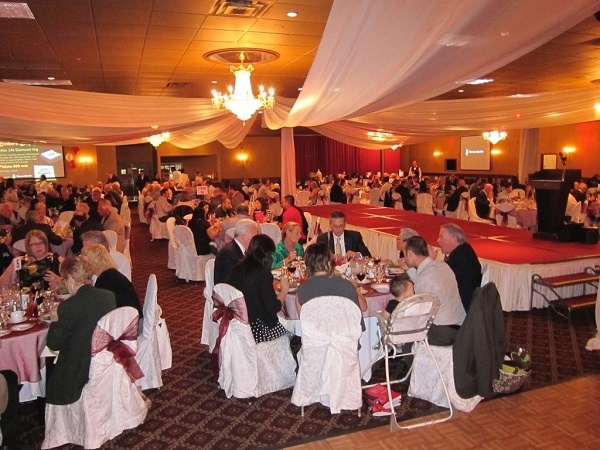
Take a look at this crowd. You can see there’s little commotion in the room. The service staff is out of the way. Everybody’s seated with food in their mouths. You might play some light background music, but there’s not too much table chatter going on.
With this setup, it’s very, very easy for the auctioneer at this point to step up on the stage, grab and hold everybody’s attention.
In my experience, guests don’t mind their dinner being ‘intruded’ because the live auction is so entertaining. I’ve consistently found this strategy helps make the most money from your auction.”
This is an easy way to capture bidders’ attention while keeping non-bidders entertained.
Note: Don’t begin the live auction as soon as people sit down. Guests will enjoy socializing and visiting others around the tables. Allow adequate time to get settled and catch up with others, then about midway through the meal – perhaps once the entrée has been set at the tables and people have started digging in – you can go ahead and begin.
-
Limit the meal to three courses.
The idea here is respecting your donors’ time and physiology. Since bidding requires plenty of momentum and energy in the room, you don’t want any part of the program to drag longer than necessary.
Even for the largest galas, we recommend keeping the menu to three courses max. The reason: Every course requires setting and clearing all tables. Too many courses, and the commotion from the service staff can drown out the live auction and distract the crowd.
An appetizer, entree and dessert are plenty for a filling, delicious meal.
{{cta(‘637a7a3d-6d30-4fe0-9be2-d2d0a049703b’,’justifycenter’)}}
-
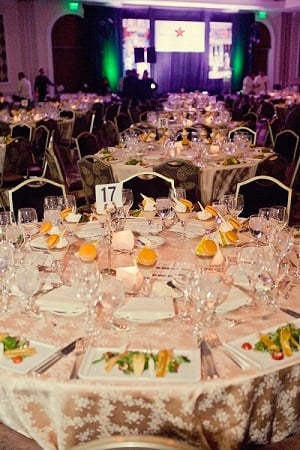 Avoid dim lighting.
Avoid dim lighting.
People don’t go to fundraising galas to have a romantic dinner. They are there to have fun! Dim lighting can induce a post-meal “food coma” of sleepiness – so keep the lights on and everyone engaged.
-
Avoid a cash bar at a plated dinner.
Cash bars are fine for fundraising events; guests understand you are raising money for a cause. The problem is, once guests have sat down to enjoy a 3-course meal, it’s awkward and distracting to have to get up from their seats to buy a glass of wine across the room.
-
Sell dinners early.
If you’ve procured a group dinner (perhaps a table for 4 at a restaurant, a catered lunch at work or private cooking lessons at home) or other gourmet food item, try to sell those sooner rather than later in the live auction. Why? It’s the same reason we spend 64 percent more money and fill our carts with junk food when hungry – people tend to spend more when they have an appetite.
Guests will pay a lot more money for those restaurant packages or dinner with the rotary president if presented before they’re stuffed.
{{cta(‘2493c44f-abf9-49d3-8678-cf7059e8567b’,’justifycenter’)}}
Scenario 2: Buffet
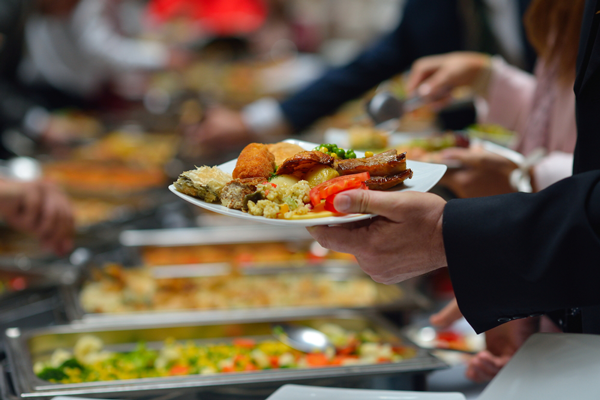
Having a buffet instead of a plated dinner? Hold off on the live auction until guests have all gone through the buffet line and everybody has their meal. Then go ahead and start the live auction whenever you can slide it in.
It’s fine if some people are still milling about or have gotten up to get seconds – just be sure to invest in a good sound system so you can be heard above the chatter and noise.
Buffets also present a unique opportunity to start the night’s fundraising with a bang: Try auctioning off the chance to be the first person at the buffet line! Here’s how your auctioneer can set it up:
“Folks, the first item we’re selling tonight is the coveted chance to be the first person in the buffet line. You might want to bid on this item because we’ve sold 250 tickets, but we only have enough food for 220 people!” (This is a joke, of course, meant to get the crowd laughing.)
“And the other reason you might want to consider bidding on this is, whoever buys this opportunity will also get to choose which table in the room here tonight goes last!”
In one such instance, Danny Hooper recalls a local businessman paid $8,000 to be the first one to dinner. Then, at the benevolent agreement of the winning bidder, a competitor matched his bid and got to go through the line at the same time. The charity had earned $16,000 right off the bat.
Talk about an exclusive auction item and successful icebreaker!
{{cta(‘bc4b315d-659b-4f3f-b7ab-190318c1f75a’,’justifycenter’)}}
Scenario 3: Small bites and sips
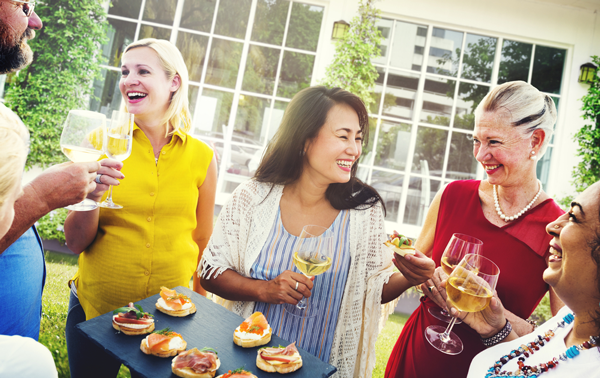
Tasting or happy-hour style auction events, such as h’ors d’eouvres, wine and craft beer tastings, food trucks, tasting booths, cocktails and more, provide a sophisticated atmosphere while being more laidback than a formal black-and-white gala.
Since everyone’s milling around and socializing, there likely aren’t enough seats for all attendees or a rigid program in place.
Nonetheless, you can still successfully incorporate an auction.
Try setting up some chairs, maybe 20 or 30, right up in front of the stage. (While the live auction may haul in the majority of your raised funds, keep in mind only a fraction of attendees will actually participate.)
Once the seats are arranged, have the emcee explain the setup: “These chairs are for people who would like to participate in the live auction. We are going to get started promptly at 7pm, so feel free to join us or listen in at that time.”
In a fluid situation like a tasting event, it’s especially important to have (1) a great sound system and (2) a dynamic host at the helm. You need a friendly, outgoing emcee who can get and hold the attention of a crowd.
{{cta(‘212f770f-b01c-440a-8592-b2fad17e7586′,’justifycenter’)}}
Scenario 4: “Dry” Lunchtime Auction
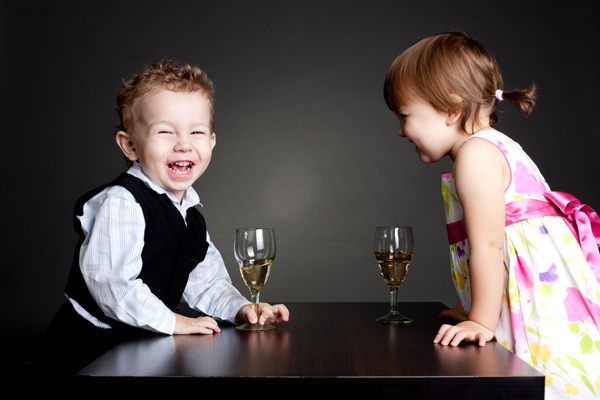
We know wine and cocktails are practically staples in evening fundraising events. However, they’re not for everyone. Your event may be earlier in the day, cater to families, take place in a municipality that doesn’t allow the sale of alcohol, have a tight budget…you get the idea.
So what if you’re holding a lunchtime event that doesn’t have alcohol? Will people still have fun and bid on your items?
In our experience, you don’t need alcohol to have a successful event. Fact is, alcohol can be a slippery slope. Serving drinks and wine does help people loosen up and relax, but at the same time, it’s more difficult for the auctioneer to control table chatter and hold their focus. So auctions with and without alcohol are both capable of extracting bids.
Focus instead on procuring high quality auction items and acquiring event sponsorships to generate the needed revenue.
{{cta(‘f2a7ad66-bc37-4f6f-ac57-1560c652588b’,’justifycenter’)}}
Food + Fundraising: General tips
-
Offer choices.
What your audience likes to eat will vary widely, but these days many donors are veering toward healthy and organic cuisine. If you suspect some in your audience would prefer lighter fare, offer at least the option to skip the white bread, fried foods and red meat in place of lean meats, fish and veggies.
-
Don’t let the meal detract from the purpose of the night.
Bottom line: You’re a charity, not a restaurant.
Of course you want the event to be elegant and sophisticated, but it’s important to keep the focus on fundraising. Don’t focus all your time and energy on creating an elaborate menu and overlook the strategies that will actually generate revenue.
For more on creating a delicous menu for charity fundraising events, check out the article below.
{{cta(‘db3294e1-033c-423a-9c51-c0f6faf47798′,’justifycenter’)}}
Want even more easy ideas and best practices for your auction? Check out our new charity event planning tool, Checklist Builder. It contains shareable to-do lists for easy task delegation, plus a wealth of resources and time-saving templates. It’s free to sign up and could be extremely helpful for you and your team as you plan your next fundraising event. Here is a little video showing how it works.
We are looking for feedback so please check it out and let us know what you think!
{{cta(‘9d8583d0-a9dd-4b60-b6e8-a24fe038ac98′,’justifycenter’)}}
